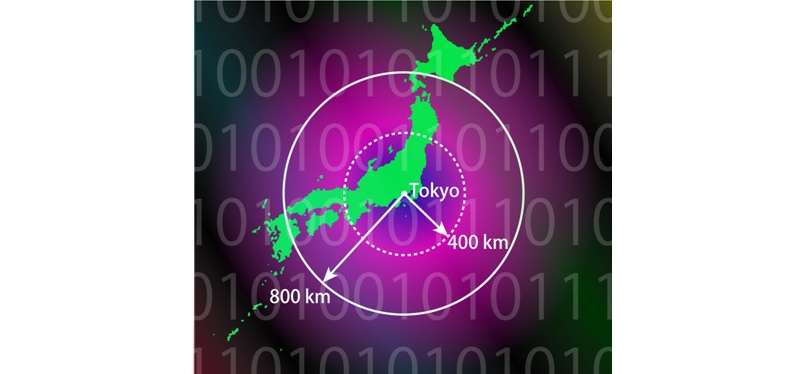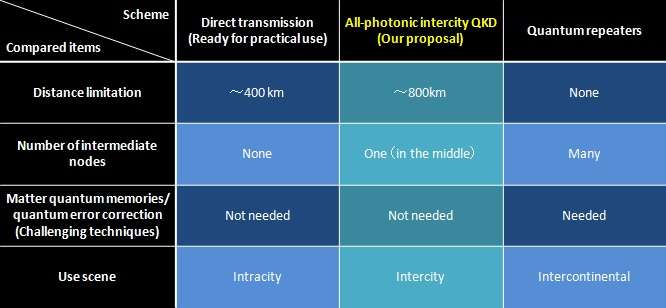January 8, 2016 feature
Intercity quantum key distribution method outperforms quantum repeaters

(Phys.org)—Quantum key distribution (QKD) may one day allow for nearly perfectly secure data communication on a large scale, but before this can happen, QKD networks must extend across distances that are large enough to connect cities and even span continents. Currently, QKD links are limited to about 400 km due to optical fiber losses, and these links can be extended using quantum repeaters, which are, however, challenging to implement at the moment.
In a new paper published in Nature Communications, Dr. Koji Azuma et al., from Nippon Telegraph and Telephone Corporation (NTT) Basic Research Laboratories in Atsugi, Kanagawa, Japan, have proposed an alternative method of expanding QKD networks that is entirely based on light and doesn't require quantum repeaters.
"Currently, the only known way to securely extend the achievable distance of the QKD links is to use quantum repeaters," Azuma told Phys.org. "While quantum repeaters are certainly necessary for intercontinental backbone links, they are likely to be an overkill in terms of their enormous communication resources for the intercity communication ranges. Our new QKD protocol presents an alternative for users by connecting places within an 800 km radius in a cost-effective and high-speed manner."
The new protocol relies solely on manipulating and measuring the quantum properties of light. As the researchers explain, the advantages of the new protocol arise from the fact that it is entirely optical and doesn't require the complexities that quantum repeaters do, such as matter-based quantum memories, large numbers of qubits, and quantum error correction techniques.
"In contrast to quantum repeaters, our protocol uses just a single intermediate node equipped only with optical devices," Azuma said. "Nonetheless, it could outperform even quantum repeaters for the communication range. This is remarkable in the sense that our protocol occupies an essential position to bridge gaps between the current QKD links and future quantum repeaters in terms of the required technological levels as well as the effective communication distances."

The researchers have theoretically shown that the current version of the new protocol can extend a QKD link from 400 km to about 800 km, and this distance could likely be increased with future modifications. Beyond this distance, quantum repeaters would still be needed. But overall, the researchers expect the new protocol to cut the number of repeater nodes in half, while keeping the communication efficiency the same.
Because some quantum repeaters will still be needed for long-distance QKD links such as intercontinental links, the researchers have also been working on improving quantum repeaters. In an earlier paper in collaboration with Prof. Hoi-Kwong Lo at the University of Toronto, they designed all-optical quantum repeaters that don't require matter-based quantum memories. The researchers predict that, when combined with the new all-optical protocol, the all-optical quantum repeaters could pave the way toward the all-optical realization of a global QKD network.
"The advantages of an all-optical worldwide QKD network are many," Azuma said. "For instance, the all-optical network serves the 'highest' communication rate that is determined only by the repetition rate of the optical devices, irrespectively of the communication distance. This is in striking contrast to usual schemes necessitating a memory function of matter, whose communication rate is, at least, bounded by the (inverse of) memory time. In addition, the absence of matter systems makes a challenging interface between matter and light completely unnecessary. Moreover, our protocol could work at room temperature in principle, thanks to its all-photonic nature. Therefore, the all-optical approach is a promising solution for realizing a high-speed and cost-effective worldwide QKD network."
In the near future, the researchers plan to perform proof-of-principle experiments for these new all-photonic schemes.
"This is an interesting challenge, not only for the community of quantum information science, but also for the conventional communications (like our company NTT) where the all-optical approach has already played an important role," Azuma said.
More information: Koji Azuma et al. "All-photonic intercity quantum key distribution." Nature Communications. DOI: 10.1038/ncomms10171
Journal information: Nature Communications
© 2016 Phys.org



















